UNION AND INTERSECTION OF SETS
Union of Two Sets :
The union of two sets contains all the elements contained in the both sets without repetition of elements.
The union is notated A⋃B.
Intersection of Two Sets :
The intersection of two sets contains the element which are common to both the sets.
The intersection is notated A ⋂ B.
Example 1 :
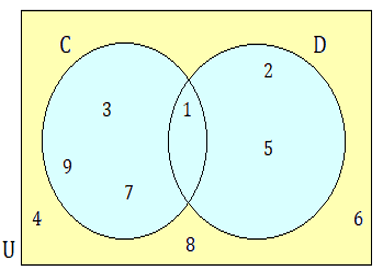
List :
(i) set C
(ii) set D
(iii) set U
(iv) set CnD
(v) set CUD
Solution :
(i) set C
The elements in set C = {1, 3, 7, 9}
(ii) set D
The elements in set D = {1, 2, 5}
(iii) set U
The universal set with all the elements in set
U = {1, 2, 3, 4, 5, 6, 7, 8, 9}
(iv) set CnD
The common elements in sets C and D is
C n D = {1}
(v) set C U D
All the elements in sets C and D is
CUD = {1, 2, 3, 5, 7, 9}
Example 2 :
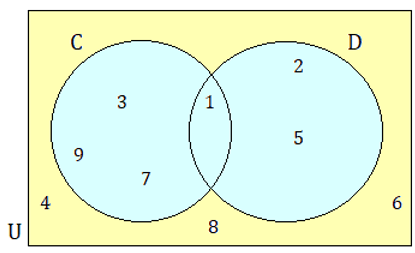
Find :
(i) n(C)
(ii) n(D)
(iii) n(U)
(iv) n(CnD)
(v) n(CUD)
Solution :
(i) n(C)
The number of elements in set C is 4.
So, n(C) = 4
(ii) n(D)
The number of elements in set D is 3
So, n(D) = 3
(iii) n(U)
The number of elements in universal set U is 9
n(U) = 9
(iv) n (CnD)
The number of common elements in sets C and D is 1.
n(CnD) = 1
(v) n (CUD)
The number of all elements in sets C and D is 6.
n(CUD) = 6
Example 3 :
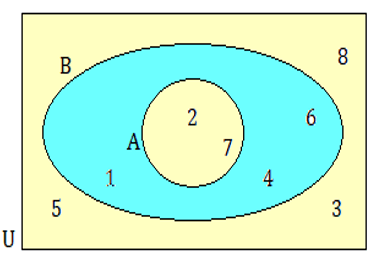
List :
(i) set A
(ii) set B
(iii) set U
(iv) set AnB
(v) set AUB
Solution :
(i) A = {2, 7}
(ii) B = {1, 4, 6, 2, 7}
(iii) U = {1, 2, 3, 4, 5, 6, 7, 8}
(iv) AnB = {2,7}
(v) AUB = {1, 2, 4, 6, 7}
Example 4 :

Find :
(i) n(A)
(ii) n(B)
(iii) n(U)
(iv) n(AnB)
(v) n(AUB)
Solution :
(i) n(A)
The number of elements in set A = 2
(ii) n(B)
The number of elements in set B = 5
(iii) n(U)
The number of elements in universal set U = 8
(iv) n(AnB)
The number of common elements in sets A and B is 2
n(AnB) = 2
(v) n(AUB)
The number of all elements in sets A and B is 5.
So, n(AUB) = 5
Example 5 :
Consider U = {x | x ≤ 12, x Є Z+}
A = {2, 7, 9, 10, 11} and B = {1, 2, 9, 11, 12}
Show these sets on a Venn diagram.
Solution :
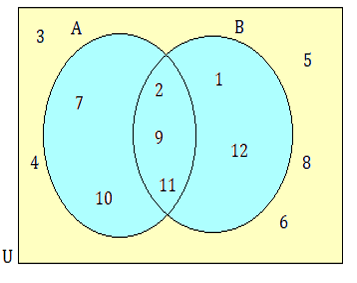
Example 6 :
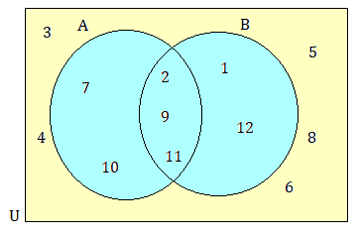
List the elements of :
(i) AnB
(ii) AUB
(iii) B’
Solution :
(i) AnB = {2, 9, 11}
(ii) AUB = {1, 2, 7, 9, 10, 11, 12}
(iii) B’
The elements which do not belong to set B is
B’ = {3, 4, 5, 6, 7, 8, 10}
Example 7 :
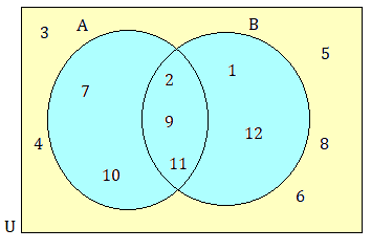
Find :
(i) n(A)
(ii) n(B’)
(iii) n(AnB)
(iv) n(AUB)
Solution :
(i) n(A) = 5
(ii) The number of elements which do not belong to set B is B’ = 7
(iii) n(AnB) = 3
(iv) n(AUB) = 7
Example 8 :
If A is the set of all factors of 36 and B is the set of all factors of 63,
Find : (a) AnB (b) AUB
Solution :
Given, A is the set of all factors of 36
So, set A = {1, 2, 3, 4, 6, 9, 12, 18, 36}
B is the set of all factors of 63
So, set B = {1, 3, 7, 9, 21, 63}
(a) AnB = {1, 3, 9}
(b) AUB = {1, 2, 3, 4, 6, 7, 9, 12, 18, 21, 36, 63}
Example 9 :
If X = {A, B, D, M, N, P, R, T, Z} and
Y = {B, C, M, T, W, Z}
Find : (a) XnY (b) XUY
Solution :
Given, X = {A, B, D, M, N, P, R, T, Z} and
Y = {B,
C, M, T, W, Z}
(a) XnY = {B, M, T, Z}
(b) XUY = {A, B, C, D, M, N, P, R, T, W, Z}
Example 10 :
If U = {x| x ≤ 30, x Є Z+}
A = {factors of 30} and B = {prime numbers ≤ 30}
Find :
(a) (i) n (A) (ii) n (B) (iii) n (A n B) (iv) n (A U B)
(b) Verify that n(AUB) = n(A) + n(B) – n(AnB)
Solution :
Given, A = {1, 2, 3, 5, 6, 10, 15, 30}
B = {2, 3, 5, 7, 11, 13, 17, 19, 23, 29}
(i) n(A) = 8
(ii) n(B) = 10
(iii) n (AnB) = 3
(iv) n (AUB) = 15
(b) n(AUB) = n(A) + n(B) – n(AnB)
15 = 8 + 10 – 3
15 = 18-3
15
= 15
Hence it is verified.
Kindly mail your feedback to v4formath@gmail.com
We always appreciate your feedback.
©All rights reserved. onlinemath4all.com
Recent Articles
-
Trigonometry Even and Odd Iidentities
May 05, 24 12:25 AM
Trigonometry Even and Odd Iidentities -
SOHCAHTOA Worksheet
May 03, 24 08:50 PM
SOHCAHTOA Worksheet -
Trigonometry Pythagorean Identities
May 02, 24 11:43 PM
Trigonometry Pythagorean Identities

